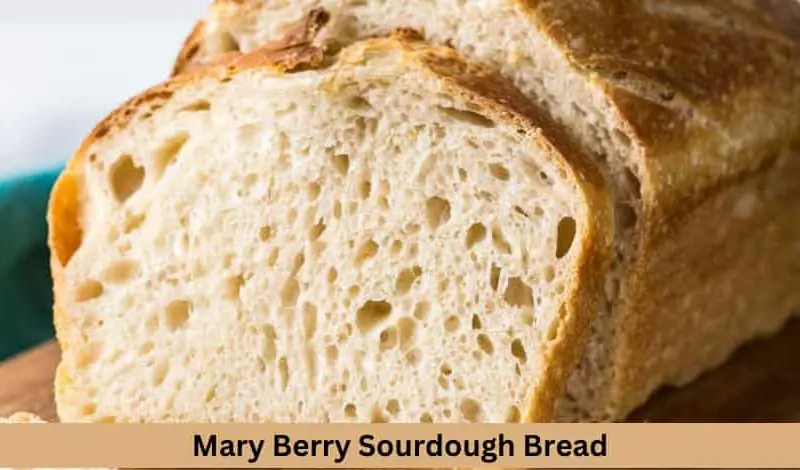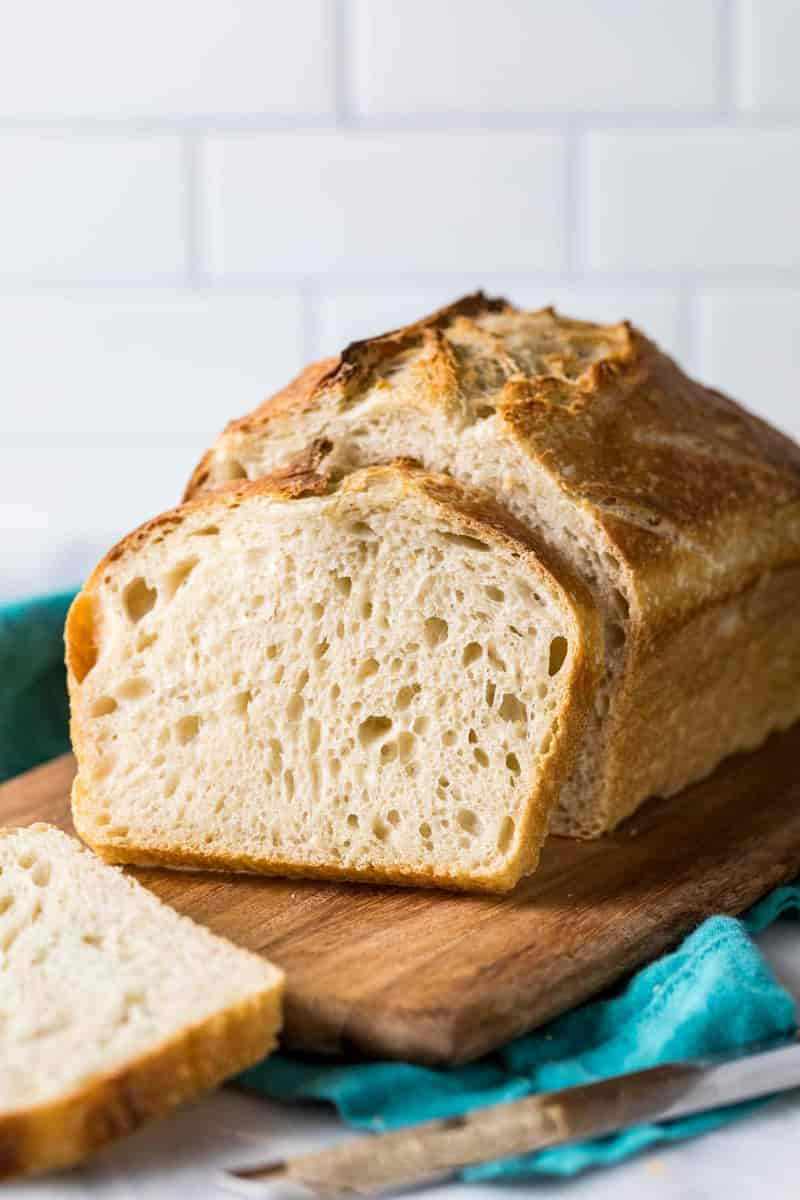
Today, I am going to make Mary Berry’s Sourdough Bread, a classic bread that brings together the simple joys of baking with the rich flavors of traditional sourdough. This recipe is perfect for anyone looking to try their hand at sourdough bread, offering a straightforward approach to creating a loaf with a beautifully crispy crust and a soft, airy inside. It’s the kind of bread that’s perfect for any occasion, from a casual breakfast to a more formal dinner party.
This recipe serves 6-8 people and will take some time, about several hours to a day, allowing for the slow fermentation that sourdough is known for. But don’t let that discourage you. The wait is well worth it, and I’m here to walk you through each step, sharing tips and tricks to make sure you end up with a delicious loaf of bread.
So, let’s get started on this baking adventure together.
What is Mary Berry Sourdough Bread?
Mary Berry Sourdough Bread is a classic rendition of the traditional sourdough loaf, characterized by its robust flavor and chewy texture. It marries the simplicity of flour, water, and salt with the complexity of natural yeast cultivation, resulting in a bread that’s not only delicious but also deeply satisfying to make.

Other Bread Recipes to Try
Why You’ll Love This Recipe
- Nutritious and Wholesome: Sourdough fermentation enhances the nutritional value of bread, making it easier to digest and more beneficial for your health.
- Exceptional Flavor and Texture: The slow fermentation process develops a depth of flavor and a perfect crumb texture that commercial bread simply can’t match.
- Versatile: This sourdough bread is the perfect base for a variety of dishes, complementing everything from simple butter to elaborate spreads and sandwich fillings.
- Rewarding Baking Experience: The process of making sourdough from scratch provides a fulfilling sense of accomplishment, along with delicious results.
Ingredients Needed to Make Mary Berry Sourdough Bread
You need the following ingredients to make this recipe:
- Starter Culture: 1 cup (active sourdough starter)
- Flour: 3 ½ cups (bread flour or all-purpose flour, with more for dusting)
- Water: 1 ½ cups (lukewarm, to activate the starter)
- Salt: 2 teaspoons (to taste)
- Sugar: 1 teaspoon (optional, to aid fermentation)
Instructions to Make Mary Berry Sourdough Bread
To make Mary Berry sourdough bread follow, these simple steps:
Step 1: Prepare the Starter
- Ensure your sourdough starter is active. If it’s been in the fridge, feed it with equal parts flour and water, and let it sit at room temperature for 12-24 hours until bubbly and active.
Step 2: Mix the Dough
- In a large bowl, combine the active starter with lukewarm water. Gradually add the flour and salt, mixing until a shaggy dough forms. Cover and rest for 30 minutes to allow the flour to hydrate.
Step 3: Knead the Dough
- Turn the dough onto a floured surface and knead for about 10 minutes, until smooth and elastic. Place in a lightly oiled bowl, cover, and let rise until doubled in size, typically 6-12 hours depending on the room temperature.
Step 4: Shape the Loaf
- Gently deflate the dough and shape it into a round loaf. Place it seam-side up in a well-floured proofing basket or a bowl lined with a floured towel. Cover and let it rise again for 2-4 hours, or until puffy and almost doubled.
Step 5: Bake the Bread
- Preheat your oven to 450°F (230°C) with a Dutch oven inside. Carefully invert the dough onto a parchment paper, score the top with a sharp knife, and transfer it into the hot dutch oven. Bake with the lid on for 20 minutes, then remove the lid and bake for another 25-30 minutes until golden brown and hollow-sounding when tapped.
Step 6: Cool and Enjoy
- Let the bread cool on a wire rack for at least an hour before slicing. This allows the crumb to set and the flavors to develop fully.

What Do I Serve With Mary Berry Sourdough Bread?
- With Savory Spreads: Complement its tangy flavor with rich butter, creamy avocado, or a hearty hummus.
- As a Sandwich Base: Elevate your sandwiches with this sourdough, perfect for both cold cuts and grilled veggies.
- With Soups and Stews: Use it to sop up the flavorful broths of your favorite soups and stews.
- For Breakfast: Toast slices and top with poached eggs, smoked salmon, or a drizzle of honey for a delectable start to your day.
Expert Tips to Make Perfect Mary Berry Sourdough Bread
- Maintain a Healthy Starter: The key to great sourdough bread begins with a vibrant, active starter. Feed it regularly and keep it at a consistent temperature.
- Hydration Matters: Adjust the amount of water based on the flour’s absorption rate. A well-hydrated dough yields a better crumb structure.
- Temperature Control: Fermentation times can vary greatly with temperature. A warmer environment speeds up the process, while cooler conditions slow it down.
- Autolyse for Better Texture: Allowing the mixed dough to rest before adding salt and starting the kneading process can improve gluten development and hydration.
- Mind the Salt: Salt regulates yeast activity and strengthens gluten structure. Ensure it’s evenly distributed throughout the dough.
- Gentle Shaping: Handle the dough with care to maintain gas bubbles. Gentle shaping helps retain the bread’s airy texture.
- Score for Success: Scoring the dough just before baking helps it expand uniformly, preventing cracks and creating a beautiful crust.
- Use Steam for Crispy Crust: Baking the bread in a preheated dutch oven or creating steam in the oven helps achieve a glossy, crispy crust.
- Patience Pays Off: Allow the bread to fully cool before slicing to let the crumb structure set, ensuring the perfect texture and flavor.
Variations of Mary Berry Sourdough Bread
- Whole Wheat Sourdough: Substitute a portion of the all-purpose flour with whole wheat flour for a nuttier flavor and denser texture.
- Olive and Rosemary Sourdough: Add chopped olives and fresh rosemary to the dough for a Mediterranean twist.
- Cinnamon Raisin Sourdough: Incorporate cinnamon and raisins into the dough for a sweet, flavorful loaf perfect for breakfast.
- Seeded Sourdough: Mix in a variety of seeds, such as sunflower, pumpkin, and sesame, for added texture and nutritional value.
- Cheese and Jalapeño Sourdough: Embed cubes of cheese and diced jalapeños into the dough for a spicy, savory loaf.
- Garlic Herb Sourdough: Knead minced garlic and dried Italian herbs into the dough for an aromatic, flavorful bread.
How do I Store Mary Berry Sourdough Bread Leftovers?
- At Room Temperature: Keep the bread in a bread box or wrapped in a clean cloth for up to 3 days to maintain its crust and soft interior.
- Freezing for Longevity: Slice and freeze the bread in an airtight bag. Frozen slices can be toasted directly for a quick, delicious option.
- Avoid Refrigeration: Storing bread in the refrigerator can dry it out and accelerate staling. Opt for room temperature or freezing instead.
How do I Reheat Mary Berry Sourdough Bread Leftovers?
- Oven Reheating: Wrap the bread in aluminum foil and warm it in a preheated oven at 350°F (175°C) for about 10-15 minutes.
- Toasting: For individual slices, a toaster or toaster oven works perfectly to refresh the bread and crisp the crust.
- Skillet Warming: Heat slices in a dry skillet over medium heat for a crispy exterior without drying out the bread.
Nutritional Value (per slice, estimated):
- Calories: Approximately 140-160 calories
- Carbohydrates: Around 30g
- Protein: About 4-5g
- Fat: Less than 1g (sourdough bread is generally low in fat unless additional ingredients like olive oil are incorporated into the recipe)
- Fiber: 1-2g
- Sugars: Less than 1g (natural sugars from the flour; no added sugars unless specified in the recipe)
- Sodium: Approximately 200-400mg (depending on the amount of salt used in the recipe)
FAQs
Why is sourdough bread not fattening?
Sourdough bread is considered less fattening than many other types of bread due to its unique fermentation process. The natural fermentation of the sourdough starter helps break down the starches in the flour, potentially reducing the bread’s glycemic index (GI). A lower GI means the bread has a lesser impact on blood sugar levels, which can help in managing weight. Additionally, the fermentation process may improve the bioavailability of nutrients, making it a more satisfying option that could help with portion control and weight management.
Is sourdough the healthiest bread?
Sourdough is often considered one of the healthiest bread options due to its fermentation process, which can make the nutrients in the flour more accessible and reduce the presence of antinutrients like phytic acid. This process also helps to pre-digest some of the gluten, which may make sourdough easier to digest for some people. Moreover, sourdough typically has a lower glycemic index compared to other breads, meaning it has a less significant impact on blood sugar levels. These factors contribute to its reputation as a healthy choice.
What is the mother of sourdough bread?
The “mother” of sourdough bread refers to the original sourdough starter from which other starters are derived or refreshed. It’s a fermented mixture of flour and water that contains wild yeast and beneficial bacteria. This starter is the heart of sourdough bread making, as it causes the dough to rise and gives sourdough its characteristic tangy flavor. Maintaining a healthy mother starter is crucial for successful sourdough baking, as it can be kept and used for many years, with portions taken to create new batches of dough.
Can I use all-purpose flour instead of bread flour for Mary Berry’s Sourdough Bread?
Yes, you can use all-purpose flour in place of bread flour for Mary Berry’s Sourdough Bread. Although bread flour has a higher protein content, which contributes to a stronger gluten network and a slightly chewier texture, all-purpose flour is a suitable substitute. Your sourdough bread will still have a delightful flavor and texture, but the crumb may be a tad less chewy. Remember to monitor the hydration of your dough, as different flours absorb water differently.
How can I tell if my sourdough starter is ready to use in the recipe?
Your sourdough starter is ready to use when it’s bubbly and active, and has doubled in volume after its last feeding. A simple test to check its readiness is the “float test.” Drop a small amount of starter into a bowl of water; if it floats, it’s filled with enough air and fermentation gases to leaven your bread effectively. This usually happens within 12-24 hours of feeding at room temperature. An active starter is crucial for the success of your sourdough bread, ensuring it rises properly and develops a good flavor.
Final Words
Starting your sourdough baking journey with Mary Berry’s Sourdough Bread recipe means more than just making a loaf of bread. It’s about enjoying the baking process, learning to be patient, and enjoying the tasty results. Whether you’re new to baking or have lots of experience, this recipe is a great way to get creative in the kitchen. Happy baking, and may your home smell wonderful with the scent of fresh sourdough bread.

